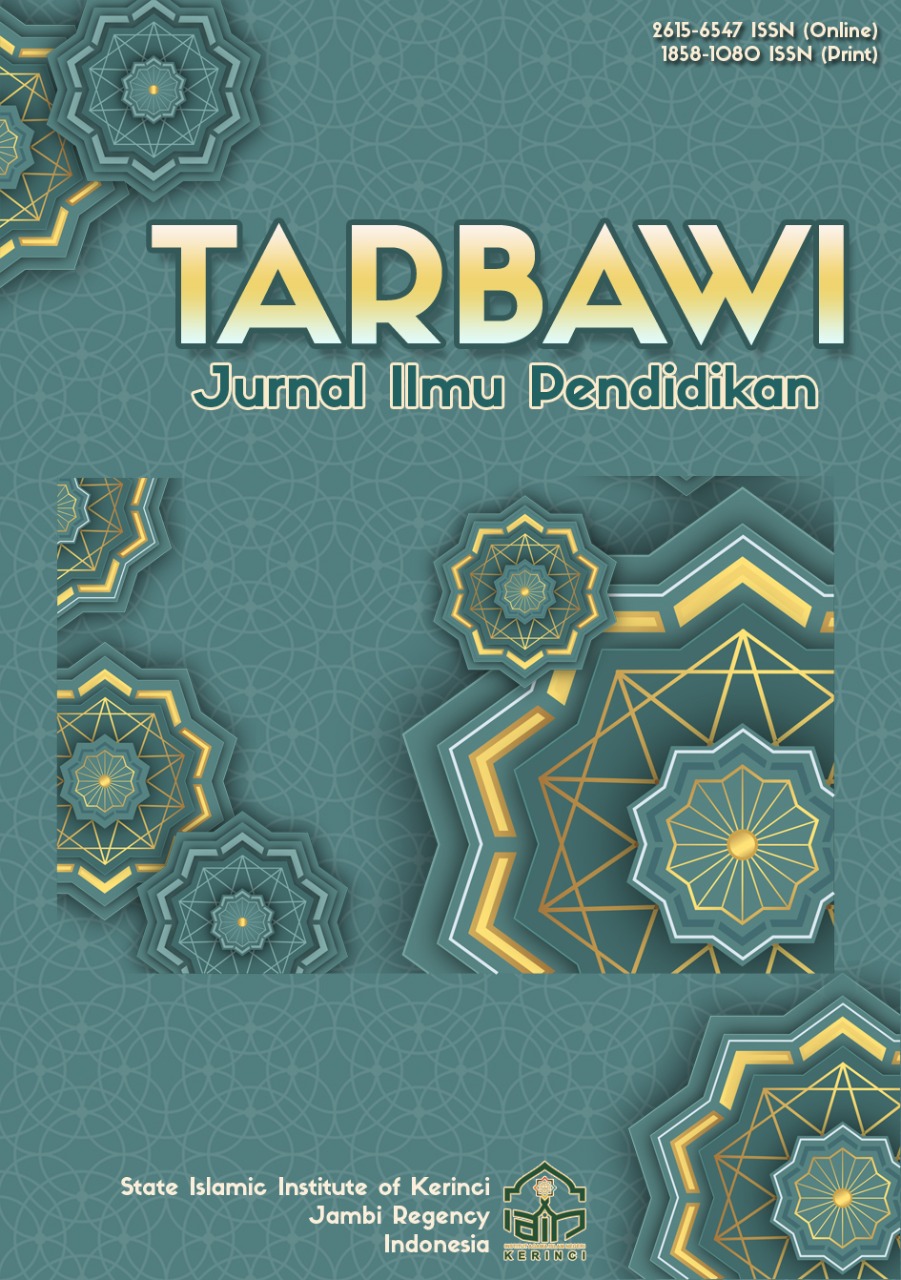Critical Thinking Skills in Rotational Dynamics: Learning Physics With and Without Free-body Diagrams
DOI:
https://doi.org/10.32939/tarbawi.v19i2.4215Keywords:
Critical thinking, Free-body diagrams, Physics learning, Quasi-experimental, Rotational dynamicsAbstract
This quasi-experimental study investigates the impact of using free-body diagrams on the critical thinking skills of students studying rotational dynamics at MAN 1 Sungai Penuh. The study involved 140 eleventh-grade students, divided into an experimental group and a control group, each consisting of 70 students. The experimental group received instruction using free-body diagrams, while the control group followed traditional teaching methods. Critical thinking skills were assessed using a test comprising five essay questions, each representing different aspects of critical thinking: likelihood and uncertainty analysis, problem solving and decision making, reasoning, hypothesis testing, and argument analysis. Descriptive statistics and independent samples t-tests were employed to analyze the data. The results revealed that the experimental group outperformed the control group in all aspects of critical thinking skills, with statistically significant differences and strong effect sizes. Specifically, the experimental group showed notable improvements in argument analysis, reasoning, and hypothesis testing. The findings suggest that the use of free-body diagrams significantly enhances students' critical thinking skills in the context of rotational dynamics. This study underscores the importance of incorporating visual learning aids in physics education to foster deeper understanding and improve analytical skills. The results have important implications for teaching practices, advocating for the integration of free-body diagrams to develop students' higher-order thinking skills effectively
Downloads
References
Aprilia, S. L., Pranata, O. D., & Haryanto, T. (2023). Analisis Tingkat Familiaritas Siswa Terhadap Istilah Sains dan Biologi. Bioedusains:Jurnal Pendidikan Biologi Dan Sains, 6(2), 580–591.
Aviani, I., Erceg, N., & Mešić, V. (2015). Drawing and using free body diagrams: Why it may be better not to decompose forces. Physical Review Special Topics - Physics Education Research, 11(2), 1–14. https://doi.org/10.1103/PhysRevSTPER.11.020137
Berge, M., & Weilenmann, A. (2014). Learning about friction: group dynamics in engineering students’ work with free body diagrams. European Journal of Engineering Education, 39(6), 601–616. https://doi.org/10.1080/03043797.2014.895708
Brookhart, S. M. (2010). How to Assess Higher-Order Thinking Skills in Your Classroom. ASCD.
Cohen, J. (1988). Statistical Power Analysis for the Behavioral Science. Second Edition. Lawrence Erlbaum Associates.
Cohen, L., Manion, L., & Morrison, K. (2018). Research Methods in Education (Eighth edi). Routledge.
Cohen, R. J., & Swerdlik, M. E. (2009). Psychological Testing and Assessment: An Introduction to Tests and Measurement (7th Editio). The McGraw−Hil.
Davis, J. A., & Lorimer, S. (2018). Student performance on drawing free body diagrams and the effect on problem solving. ASEE Annual Conference and Exposition, Conference Proceedings, 2018-June. https://doi.org/10.18260/1-2--31013
Dwyer, C. P., Hogan, M. J., & Stewart, I. (2012). An evaluation of argument mapping as a method of enhancing critical thinking performance in e-learning environments. Metacognition and Learning, 7(3), 219–244. https://doi.org/10.1007/s11409-012-9092-1
Ennis, R. H. (1993). Critical Thinking Assessment. In Theory Into Practice (Vol. 32, Issue 3, pp. 179–186). https://doi.org/10.1080/00405849309543594
Etkina, E., & Planinšič, G. (2015). Defining and Developing “ Critical Thinking ” Through Devising and Testing Multiple Explanations of the Same Phenomenon. The Phy, 53(October), 432–437. https://doi.org/10.1119/1.4931014
Etkina, E., Van Heuvelen, A., White-Brahmia, S., Brookes, D. T., Gentile, M., Murthy, S., Rosengrant, D., & Warren, A. (2006). Scientific abilities and their assessment. Physical Review Special Topics - Physics Education Research, 2(2), 1–15. https://doi.org/10.1103/PhysRevSTPER.2.020103
Fredlund, T., Linder, C., Airey, J., & Linder, A. (2014). Unpacking physics representations: Towards an appreciation of disciplinary affordance. Physical Review Special Topics - Physics Education Research, 10(2), 1–13. https://doi.org/10.1103/PhysRevSTPER.10.020129
Giri, V., & Paily, M. U. (2020). Effect of Scientific Argumentation on the Development of Critical Thinking. Science and Education, 29(3), 673–690. https://doi.org/10.1007/s11191-020-00120-y
Halpern, D. F. (2014). Thought and Knowledge. An Introduction to Critical Thinking. Psychology Press.
Heafner, J. (2015). The language of the arrows. The Physics Teacher, 53(7), 445–446. https://doi.org/10.1119/1.4931020
Judge, B., Jones, P. J., & McCreery, E. (2009). Critical Thinking Skills for Education Students. Learning Matters Ltd.
Leech, N. L., Barret, K. C., & Morgan, G. A. (2005). SPSS for Intermediate Statistics. Use and Interpretation. Lawrence Erlbaum Associates, Inc. All.
Lin, S. Y., & Singh, C. (2015). Effect of scaffolding on helping introductory physics students solve quantitative problems involving strong alternative conceptions. Physical Review Special Topics - Physics Education Research, 11(2), 1–19. https://doi.org/10.1103/PhysRevSTPER.11.020105
Lo, W., & Beichner, R. J. (2019). Stick With It! Helping Students Understand Free-Body Diagrams – A Magnet Activity as a Tool for Understanding. The Physics Teacher, 57(7), 459–461. https://doi.org/10.1119/1.5126823
Mešić, V., Mahmutović, S., Hasović, E., & Erceg, N. (2017). Free-Body Diagrams and Problem Solving in Mechanics: An Example of The Effectiveness of Self-Constructed Representations. European J of Physics Education, 7(3), 1309–7202.
Morgan, G. A., Leech, N. L., Gloeckner, G. W., & Barret, K. C. (2004). SPSS for Introductory Statistics. Use and Interpretation. Lawrence Erlbaum Associates, Inc. All.
Pranata, O. D. (2017). Analisis penguasaan konsep dan kemampuan berpikir kritis siswa dalam pembelajaran interactive demonstration dengan bantuan free-body diagram pada materi dinamika rotasi di SMA Negeri 2 Sungai Penuh-Jambi. In Universitas Negeri Malang. Universitas Negeri Malang.
Pranata, O. D. (2024). Analisis Kualitas Free-Body Diagram, Penguasaan Konsep Siswa, dan Korelasinya Pada Materi Dinamika. Jurnal Ilmu Fisika Dan Pembelajarannya (JIFP), 8(1), 26–37. https://doi.org/10.19109/rf6wgk84
Pranata, O. D., & Lorita, E. (2023). Analisis Korelasi Kemampuan Berbahasa Panah Dengan Kualitas Free-Body Diagram Siswa Pada Materi Dinamika. Jurnal Pendidikan Fisika Dan Sains, 6(1), 22–31. https://doi.org/10.52188/jpfs.v6i1.394
Pranata, O. D., Wartono, W., & Yuliati, L. (2016). Kesulitan siswa SMA pada Penggunaan Free-body Diagram dalam Materi Dinamika. Proseiding Seminar Nasional Pendidikan IPA Pascasarjana UM, 394–404. http://pasca.um.ac.id/wp-content/uploads/2017/02/Ogi-Danika-394-404.pdf
Pranata, O. D., Yuliati, L., & Wartono. (2017). Concept Acquisition of Rotational Dynamics by Interactive Demonstration and Free-Body Diagram. Journal of Education and Learning (EduLearn), 11(3), 291–298. https://doi.org/10.11591/edulearn.v11i3.6410
Reiss, M. J., & Winterbottom, M. (2021). Teaching Secondary Biology. In M. J. Reiss & M. Winterbottom (Eds.), Teaching Secondary Science (3rd ed.). Hodder Education.
Rosengrant, D., Van Heuvelen, A., & Etkina, E. (2009). Do students use and understand free-body diagrams? Physical Review Special Topics - Physics Education Research, 5(1), 1–13. https://doi.org/10.1103/PhysRevSTPER.5.010108
Savinainen, A., Mäkynen, A., Nieminen, P., & Viiri, J. (2013). Does using a visual-representation tool foster students’ ability to identify forces and construct free-body diagrams? Physical Review Special Topics - Physics Education Research, 9(1), 1–11. https://doi.org/10.1103/PhysRevSTPER.9.010104
Stadlbauer, J. M., Kehrer, L., & Bauer, S. (2018). Using history to foster critical scientific thinking: Aristotle and Galileo’s debate resolved through high-speed motion tracking in the classroom. American Journal of Physics, 86(12), 903–908. https://doi.org/10.1119/1.5062167
Stobaugh, R. (2013). Assessing Critical Thinking in Middle and High Schools. Meeting the Common Core. Routledge.
Thabit, A. K., Mater, A. N., & Al-Nami, A. (2016). A study of the effect of student utilization of the free-body diagram on their performance. International Journal of Educational Research and Reviews, 4(1), 577–582. www.internationalscholarsjournals.org
Tiruneh, D. T., De Cock, M., Weldeslassie, A. G., Elen, J., & Janssen, R. (2016). Measuring Critical Thinking in Physics: Development and Validation of a Critical Thinking Test in Electricity and Magnetism. International Journal of Science and Mathematics Education, 15(4), 663–682. https://doi.org/10.1007/s10763-016-9723-0
Tiruneh, D. T., Weldeslassie, A. G., Kassa, A., Tefera, Z., De Cock, M., & Elen, J. (2015). Systematic design of a learning environment for domain-specific and domain-general critical thinking skills. Educational Technology Research and Development, 64(3), 481–505. https://doi.org/10.1007/s11423-015-9417-2
Winter, J. de, & Hardman, M. (2020). Teaching Secondary Physics. In J. de Winter & M. Hardman (Eds.), Teaching Secondary Science (3rd ed.). https://books.google.com.my/books?id=ZSoryQEACAAJ
Yilmaz, R. (2017). Exploring the role of e-learning readiness on student satisfaction and motivation in flipped classroom. Computers in Human Behavior, 70, 251–260. https://doi.org/10.1016/j.chb.2016.12.085
Downloads
Published
Issue
Section
License
Copyright (c) 2024 Ogi Danika Pranata, Noperma Noperma

This work is licensed under a Creative Commons Attribution-ShareAlike 4.0 International License.









